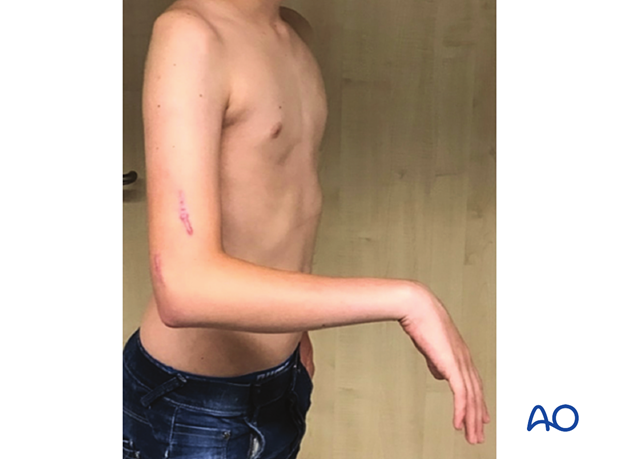Complications and technical failures
1. General considerations
Complications associated with humeral shaft fractures include:
- Delayed union
- Radial nerve injury
- Infection
- Fracture around implants
- Residual angulation
2. Delayed union
Overly rigid fixation with insufficient cortical contact may lead to delayed union, nonunion, and metal work failure.
Employing appropriate principles of fracture reduction and implant selection will reduce the likelihood of this complication.
3. Radial nerve injury
Radial nerve injury can be caused by the injury or the treatment.
5–10% of closed injuries can be associated with primary radial nerve trauma.
This is usually a neuropraxia and will resolve spontaneously. In open humeral shaft fractures, there is a higher risk of transection of the nerve, which requires surgical intervention.
The radial nerve is also at risk during reduction and plating. Make sure to identify the nerve during the approach and all steps of the treatment.
For more details, see the chapter on management of associated radial nerve injuries.
If an iatrogenic injury is identified, advice should be sought from a surgeon with competencies in peripheral nerve repair.
During insertion of implants, eg, elastic nails, in the distal humeral shaft, the safe zones for the entry points should be respected. Else, the radial nerve may be injured.
This case shows a patient with a proximal diaphyseal fracture stabilized with elastic nails. The entry points were placed too proximally, and the radial nerve has been injured, resulting in paralysis of wrist and finger extension.

4. Infection
Infection in children is less common than in adults.
This may complicate surgical fixation or occur as a consequence of an open fracture.
The risk is increased with:
- Unhealthy or broken skin
- Limb swelling
- Prolonged operation time
5. Fractures around implants
The presence of a plate on the humeral shaft produces a stress riser and there is, therefore, a risk of fracture at this level.
Implant removal may be indicated to reduce this risk particularly in active adolescents and children.













